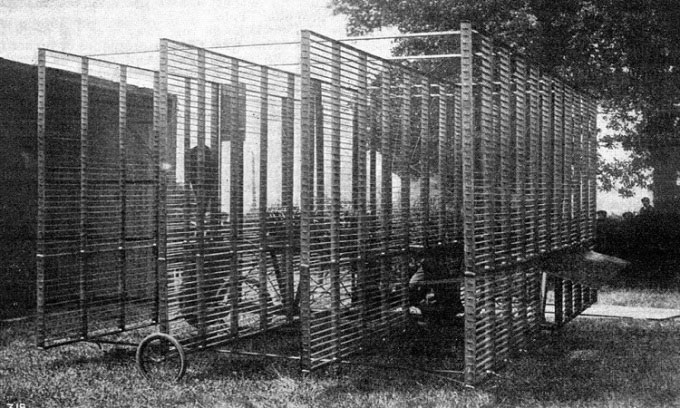British scientist Horatio Frederick Phillips once built a 200-winged aircraft capable of flying 152 meters in 1907.
In 1843, British engineer and aviator Sir George Cayley suggested that multi-winged aircraft generate more lift and ascend more easily. Many early aviation models applied this principle. Most aircraft involved in World War I were biplanes. The Fokker Dr.I, associated with the famous German pilot Manfred von Richthofen, featured three wings and performed exceptionally well. The success of the Fokker Dr.I inspired designer Anthony Fokker to add more wings, leading to the creation of the five-winged Fokker V.8. Unlike its predecessor, the Fokker V.8 was nearly unable to fly and was quickly forgotten.

The 200-winged machine is the most successful aircraft design in Horatio Frederick Phillips’s life. (Image: Amusing Planet).
British scientist Horatio Frederick Phillips also favored multi-winged aircraft and did not stop at five wings. In 1893, he built a flying machine with 50 wings and increased the number to 120 by 1902. His final aircraft, produced in 1907, had an impressive 200 wings.
Phillips was born in 1845 in Streatham, a suburb of London. As the son of a gunsmith, he developed an interest in aviation from a young age and closely followed research conducted by the Royal Aeronautical Society, utilizing a lever arm and wind tunnel. In the early 1880s, Phillips began experimenting with wing designs in a homemade wind tunnel. His wind tunnel used a steam jet to draw air into the entrance, producing airflow of better quality than early wind tunnels.
Phillips utilized the results from his wind tunnel experiments to design a series of curved wings based on the shape of bird wings. When the curvature of the upper surface of the wing is greater than that of the lower surface, air moves over the upper surface at a higher speed, creating lower pressure compared to the underside. This phenomenon generates an upward force known as lift. This is the fundamental operating principle behind all heavier-than-air flying objects.
In 1884, Phillips patented eight wings of this type with varying widths and curvatures. He received a second patent in 1891, describing his design as “double-surface wings.” While other aviators quickly adopted curved wings and achieved success (such as Otto Lilienthal in Germany, Samuel Langley, and the Wright brothers in the United States), Phillips himself faced significant failures as he focused too much on increasing the number of wings while neglecting other factors. However, his experiments were quite impressive.
In his first attempt in 1893, Phillips created an object that resembled a lifting curtain more than an aircraft. Named the Phillips Flying Machine, the design featured a long, cigar-shaped body and a rectangular frame fitted with 50 slender wings known as struts. The struts measured 5.8 to 6.7 meters in length but were only 3.8 cm wide and spaced 5 cm apart.
The propulsion came from a 6-horsepower coal-fired engine, which rotated two propellers at a speed of 400 revolutions per minute. The entire machine weighed around 160 kg. Instead of being piloted, the machine was tethered to a post and moved in a circular motion above a wooden ring with a diameter of over 60 meters. Under the pressure of the air generated beneath the struts, the flying machine reached a height of 0.6 to 0.9 meters at a speed of 64 km/h.
In 1904, Phillips produced another machine with a pilot. This machine had 21 wings and a cross-shaped tail control surface for increased stability, supported by a three-wheeled frame. This multi-winged aircraft operated using a self-constructed 22-horsepower water-cooled inline four-cylinder engine. The machine measured 4 meters in length and 3 meters in height, weighing 270 kg. Phillips managed to control the flying machine for a short distance of about 15 meters, moving at a speed of 55 km/h.
In his final attempt in 1907, Phillips built a machine with four frames and 50 wings, totaling 200 wings. This multi-winged model used a 22-horsepower engine similar to the 1904 version to drive a 2.4-meter propeller. The machine weighed 225 kg. This was Phillips’s most successful design, capable of flying approximately 152 meters. After this, Phillips ceased aircraft construction but lived long enough to witness rapid advancements in aviation during and after World War I. He passed away in 1924.


















































